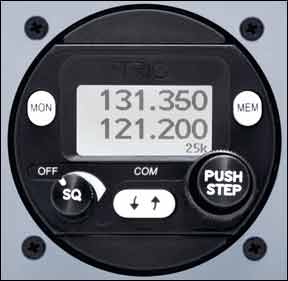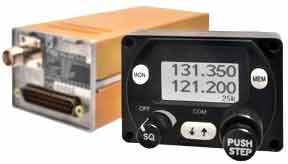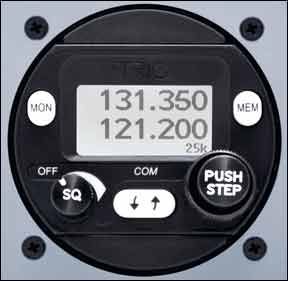Most communications radios are designed for installation into a traditional radio stack. That’s great for traditional panels, but they can be a non-starter in classic LSA and ultralight craft. The market offers few choices other than Becker Avionics for standalone comm radios that fit in tight spaces. Now UK-based Trig Avionics offers a worthy alternative with the TY-91 and TY-92 transceivers.

Space-Saving Flexibility
Trig is best known for their innovative and space-saving transponder solutions, including the recently certified TT22 ADS-B unit. The new TY-91 and TY-92 comm radios are pitched to complement the similarly packaged transponders, adding to the growing Trig product line.
The TY91 has a six-watt transmitter and can operate with 11-33 volts of input power. The 16-watt TY-92 is aimed at higher-performance aircraft with 28-volt electrical systems. Both units are certified for 25 kHz and 8.33 kHz frequency spacing. Trig says the TY91 can even be battery operated, making it an option for gliders and other aircraft without power-generating electrical systems.
What makes the TY-series unique is the two-piece design. It utilizes a remotely mounted transceiver channeled by a compact control head. The control head is designed to fit in a standard 2¼-inch instrument cutout, or any area on the panel that can accommodate the 2.4-inch wide by 1.8-inch high chassis case.
Better yet is the space saving that’s afforded behind the panel with a control head that’s only three inches deep. The remote transceiver measures 5.5-inches long and stands 1.7-inches high. Total system weight is roughly one pound.
Multi-component systems save space at the panel, but you still need to find a home for that remote box. But in Trig’s case, the remote box is so compact we don’t think finding space will be an issue even in space-challenged cabins. The two-piece design ups the installation effort, however. Speaking of installation, the hardware uses hardy and proven connectors that give the equipment big-airplane durability.

Feature-Rich Logic
The TY-series bring significant audio capability to starkly equipped aircraft. There’s an integrated two-seat intercom and for headset-free operation, the units come equipped with integral speaker amplifier for direct connection to a cabin speaker.
The controls on the radios are straightforward and simple. (Trig even boasts of easy operation while wearing gloves.) There’s a volume and squelch knob, frequency tuning knob and frequency transfer button at the bottom of the radio’s bezel. To the left of the LCD display, a frequency-monitoring button allows for monitoring the tuned standby frequency while a memory button commands the nine-frequency memory storage bank.
Budget-Minding Price
When released this fall, the six-watt TY91 is expected to list around $2000, while the higher-end TY92 will weigh in around $5000. Installation pricing will be tough to nail but we would expect pricing to be slightly less than a traditional radio since the main avionics stack won’t need to be disassembled and restacked. Of course, mounting the remote unit could make up the difference.
Transponder With That?
To complement the TY-series comm radios, Trig has also announced the the TT22, which, according to Trig, is the world’s smallest Mode-S transponder suitable for GA cockpits.
Like the TY-series radios, the TT22 is a two-piece system with a 250-watt remote unit and a space-saving control head. What we like the most about the TT22 is the integrated altitude encoder—a real space-saver for owners and convenience for technicians. The TT22 is TSO C166b-compliant, which is the ADS-B mandated standard, but will require additional STC. Street price for the TT21 control head-remote combo is just under $2300.
As an aside, Trig also offers the TT31, which is a conventional-design, panel-mount transponder aimed at directly replacing the popular Bendix/King KT76A/78A transponder with something capable of meeting the ADS-B out mandate. The TT31 is around $2800, with the King replacement model around $3300.
In a market dominated by touchscreens and 2.6-million-color LCDs, it’s refreshing to see a company addressing the needs of the simple and the small.


